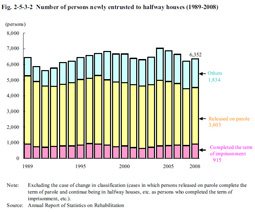| Previous Next Index Image Index Year Selection | |
|
|
2 Halfway houses Halfway houses are institutions that are commissioned mainly by probation offices to provide a variety of aid such as accommodation, meals, employment support, and living guidance, etc. to probationers/parolees or to those requiring urgent aftercare as a discharged offender.As of April 1, 2009, there were 102 halfway houses nationwide. 101 of them were being operated by juridical persons involved in offender rehabilitation and one of them by a social welfare juridical person. 89 of the facilities were for males, seven for females, and six for both males and females. The total capacity was 2,303 persons, being comprised of 1,821 male adults, 304 male juveniles, 133 female adults, and 45 female juveniles (Source: The Rehabilitation Bureau, Ministry of Justice). Fig. 2-5-3-2 shows the number of persons newly entrusted to halfway houses over the last 20 years. The number of persons newly entrusted in 2008 was 6,352, of which 3,603 (56.7%) were parolees and 915 (14.4%) were those who had completed their sentences. Fig. 2-5-3-2 Number of persons newly entrusted to halfway houses (1989–2008) Halfway houses have been making the effort to enhance their treatment function, such as through introducing Social Skills Training (SST) and education on the harmful effects of alcohol/drugs. In FY 2008, 42 halfway houses implemented SST and 23 implemented education on the harmful effects of alcohol/drugs (Source: The Rehabilitation Bureau, Ministry of Justice).Of those that left halfway houses in FY 2008, 25.0% returned to rented house, 21.9% to their workplace, and 15.1% to relatives or close associates. The most common occupation when leaving the halfway house was laboring at 46.5% of the total, followed by the service industry at 7.6%, and transport and Communications at 2.9%, while 32.2% were unemployed (Source: The Rehabilitation Bureau, Ministry of Justice). |
